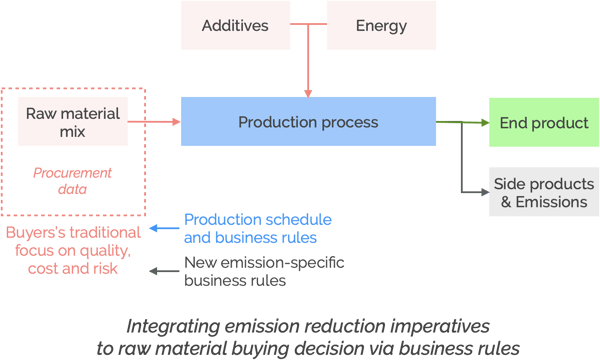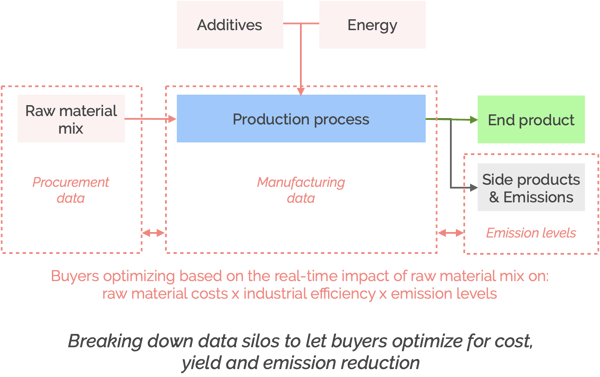"Sustainable Procurement" has become fashionable, focusing so far on tighter supplier selection and lengthier bills of materials - all good, but lacking a seamless connection to Operations.
This article discusses how raw material and energy buyers can contribute to the emission reduction objectives of their companies - continuously, directly and measurably.
1. Context
From the perspective of raw material buyers, the emission reduction challenge currently looks like this (especially for process industries, where additives and energy can compensate for changes in the raw material mix):

Buyers maintain their traditional focus on cost, quality and risk. The company's emission reduction goals translate into a new set of "green" business rules for buyers to follow. For example:
- Crushed scrap should represent 25% of our PET spend
- Coal should not exceed 1/3rd of our fuel mix
- 20% of our steel should not travel more than 1,000 km to our plants
This rule-based process suffers from two notable drawbacks.
- The contribution of Procurement to emission reduction is quite passive - more about compliance than invention, and execution than decision.
- That contribution is also not quantified. What exactly is the impact of the new business rules on emissions? Within their framework, are there unexplored optimization opportunities? Should the rules evolve, and how often?
2. Modern approach
Leveraging digital procurement technologies, companies can transform the emission reduction challenge into a typical continuous intelligence problem which:
- Mixes data streams from multiple external and internal sources (market data from professional information providers, business data from your ERP system, sensor data from your operations...).
- Combines analytical models, predictive models, and business rules for a fuller understanding of the situation.
- Is geared towards actionable recommendations ("prescriptive analytics"), not just descriptions and diagnoses.
- Runs continuously, not periodically, thus multiplying your opportunities to create value.
For raw material buyers, here is how the emission reduction challenge now looks like:

More information and better decision management transform Procurement's contribution to the company's emission reduction efforts.
3. Benefits
Really, that transformation is a graduation from execution to optimization, with the following benefits:
- Proactive contribution of Procurement to the company's emission reduction goals. These goals are transformed from business rules that buyers endure, into optimization factors that buyers own.
- Integrated and data-driven approach to emission reduction, with the ability to react to potential emission crises in real time, all along the supply and production chain.
- The power to make conscious, informed, quantified arbitrage decisions between costs, yield and eco-efficiency. You want to understand how these moving pieces interact, and to share that understating across the organization.
In our experience, industrial companies can expect a 3-5% increase in value-in-use from that dynamic approach to sustainable procurement.

